Denali National Park in Alaska is truly rugged and wild. A stunning national park to be experienced. “Denali” is the native word for “the tall one,” meaning the great mountain, or the tallest, biggest mountain for the Dene people north of the Alaska Range.
We like to start our national park journeys with the Visitor Center’s introductory film. Denali National Park is part of the “boreal” or northern forest that encircles the earth. You can hike Alaska, Canada, Scandinavia, and Siberia and always be in the same type of forest, according to informative film.
Due to the Pretty Rocks Landslide, Denali Park Road is closed at Mile 43 and is expected to remain closed through summer 2026. But don’t worry. There is plenty to do in Denali National Park.
Over our three-day visit, we tried to see as much of the park as we could. And we took the free green shuttle bus, an old school bus, to events. This helps with parking, as the park is busy in summer.
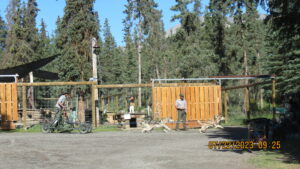
We started with the dogsled demonstration. We were in the first wave of buses to get to the kennel. The pups were a bit tired, sleeping on top of their dog houses. Their handlers said they were just fed. It was warm out for them, in the 70’s at 9:40 a.m. A few of the pups let us pet them. Siberian huskies, malamutes, and Alaskan work dogs. Sleek dogs. Muscular dogs. They wear harnesses to pull the sled.
During our demonstration, the dogs were very excited, jumping all over their handlers. When the “musher,” the guy driving the dog sled, told them to go, it was like they were shot from a cannon. They had a short loop for us to see how they worked together.
The park ranger, told us the positions of the dogs; the leader[s], swing dogs, team dogs, and wheel dogs. Dog sledding is needed in winter because the park is open. Rangers need to cut a path through the snow to check on those who visit and camp or dog sled through the park. Many come for the northern lights. Since the sun never sets in the summer, we couldn’t see the northern lights. [My only regret!]
These sled dogs are bred to work and pull sleds and use their instincts on where to go or when to stop. In 1917, fog had rolled in and the musher couldn’t see. He also couldn’t get his lead dog to move forward. So, he camped where they were. The next day, the ranger saw what his lead dog felt. A sheer cliff in front of them. Good dog!
I went for the nature talk and hike with a park ranger. We took the McKinley Station Trail. The ranger talked about Marino, an Italian, who wanted to build a villa on top of the mountain because it was decided the government would be building a train station there. Back then, there was no thick forest in this area, so the view was expansive. A person could petition land management and receive 120 acres to build on. Can you imagine that?
But…
You could only access the area by dog sled in the winter or on foot in the summer. Construction used the materials that were at hand. Marino’s “villa” was a log cabin with beds and bearskin blankets. But it was better than sleeping outside in a tent.
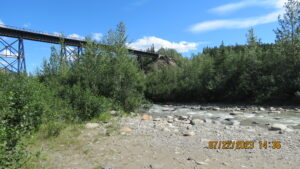
McKinley trail was a gravel path, pretty level. About 3 miles. The ranger told us that the proliferation of pine tree sprouts on a tree was because something, an insect or animal, had pierced the bark of the pine right there and the tree responded by sprouting many small branches. It’s call “witches’ broom.” It looks like a squirrel nest to me.
We crossed Hines Creek on a foot bridge. This was far below our Hurricane Gulch train bridge. We finished our hike at a relatively new suspension bridge over Riley Creek and then turned around to head back to the visitors’ center.
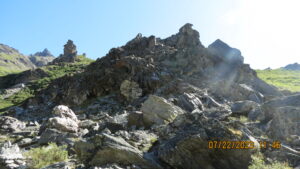
My husband and I started another hike by ourselves. A 2-mile loop along the Savage River on the valley floor. The rock was bleached from the sun. Angular in its broken pieces like cubes. Other rock was platy in that it looks like it can come apart in sheets.

The glacial-melt, silt-filled, battleship-gray Savage River is bone-chilling water. Still, the river seems tame rather than “Savage.” Even through spring thaw or a deluge of rain, the braided river never overflows its banks. In summer, the current is swift, and the water tumbles and burbles at its center. It’s a shallow river. There can be tiny fish in it, a park ranger told me. Mostly, animals come to cool off, eat plants along its banks, and drink. The Savage River flows north and, eventually, after connecting with other rivers, like the Yukon, flows into the Bering Strait.
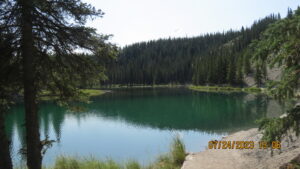
On our next visit, we hiked the Horseshoe Lake Trail. This “moderate” trail had about 360 steps in the 2.5 miles to the lake. It started out a level gravel trail, with slight inclines and downward slopes. But to get to the lake, the steps started down and down. The fresh water lake was calm and warm. Water plants grew under the surface. It appeared to have a silted bottom while the banks were thickly pined. Some teens were jumping in on the opposite side of the lake. I could see our family doing that.
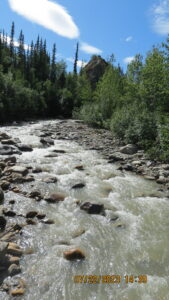
The trail continued around the lake and then through a forest, where I met the battleship gray Nenana River. Glacial ice scrapes the mountains as it recedes north in warm weather and the leftover silt turns the water gray. The Nenana is swift, roiling in its hurry to get downriver. The Nenana runs north. It will eventually empty out into the Bering Strait. I just touched it with my hands. I rubbed some of the icy water on my face and arms to cool myself down. It was 85 degrees that day, and the sun was hot.
I came back to Horseshoe Lake, following the trail. The lake is home to fish and beavers. I found a dam, with the lake flowing over the top. The turquoise waters of the Horseshoe run deep, yet you can still see plant life at the bottom. The warm water was inviting. I ran my hands through it by a sandy bank. The trail narrowed. Then I was through the forest again and had to face those blasted steps. I was dragging once I reached the top of the mountain. I caught up with another couple who told me to pass them.
“I’m in low gear,” I told them. “This is as fast as I go now.”
They laughed. We followed the Visitor Center signs back to the beginning of the trail.
Savage River is the last stop visitors can drive to; that’s mile marker 15. It’s the end of the paved road. Cars and free shuttles don’t drive on the hard-packed gravel road to mile marker 43. You need to pay for seats on a bus at the bus depot to see the East Fork extension in Denali Park. Buses fill quickly. Take the green shuttle bus. Our commentary was excellent. And it cost less than the tan buses. It’s a four-and-a-half-hour drive.
Elton Parks was our driver and guide and wore a headset so we could all hear him. He stopped at animal sightings and visual photo opportunities.
The state bird of Alaska is the Willow Ptarmigan, a puffy little bird that reminded me of a partridge. We watched a family of ptarmigans cross the road right in front of us.
Denali Mountain is in a subarctic region and is the tallest peak in North America at 20,310 feet. The national park was established in 1917 to protect wildlife. And like we learned at the dog sled presentation; the first park ranger’s job was to stop the hunting of wildlife in Denali.

The purple and pink stalk flowers along the side of the road are fireweed. We found Dall Sheep, the only wild white sheep. Arctic ground squirrels, little red guys with short and sleeker tails than our gray ground squirrels back east. Magpies are the black and white birds we’ve been seeing in the area. They have the size and shape of our east coast blue jays, without the crested head. And we saw caribou in the mountains.
Climbing season for Denali Mountain is between May and early July. The temperature up there can be 39 below during climbing season. It stops in July because the snow becomes too unstable. 100-foot crevasses open by July and the temperatures are too warm.
Igloo Mountain wears shades of rust and orange at its crest. Sable Mountain dresses in browns and dark green. Sable pass is at 3,900 feet. Polychrome Mountain, in its rust, gold, and green, is where the landslide happened that closed the one road of the park. These mountains have a volcanic rock and ash base that acts like clay when wet. It allows the larger rock to slide down the mountain. We learned so much on our bus tour.
I think the only constant in nature is change. Perhaps someone has said this before. These are my thoughts about nature. I can only share my experience with you. But to feel this change, you must go out into nature and observe. Open your senses. Why not try it? Take your family with you. You’ll be glad you did.


National Parks are great sampling of the many wonders that exist in this great country. Most are in the west but some can be found in the densely populated East. All are well worth the effort to visit.
Absolutely correct, William. Nature and national parks are always worth the effort to visit. You learn. You slow down. You breathe it all in. Thanks so much for visiting Camping with Five Kids. It’s appreciated more than you realize.